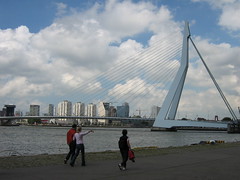OK, I charged the battery a bit, so now back to live reporting on the first day, just in time for the very last talk by Florian Cramer. I’ll go back and post my notes from the others later. A nice intro by Matthew Fuller who mentions that among other things, Florian has won in a new category for Prix Ars Electronica for best contribution to media theory. He seems embarrassed by it being mentioned. Unlike most of the other speakers, Florian is (as usual) eschewing slick presentation styles and just giving us white on black screens that look like (and in fact I think are) what you get in a terminal window.
I had the chance to see Florian’s original presentation notes and of course he’s not following them, which means now I have trouble identifying what I really need to note down. So what is he saying…he starts with talk of an “elegant paradox” between the syntactic, linear aspects of language and the paradigmatic, that is associative meanings of words. so there has always been a sort of weblike character to texts and in fact textus actually means web.
Then we are on to Barthe turning everything into a text, from beefsteaks, to striptease, to well, anything. At the same time, traditional philologists think of text as only about paper. Computer tech though has allowed us to see what really texts are or aren’t. Ok, now I know where we are.
Syntax –> what is computable
Semantics –> what is computable only if turned into syntax
so text is just an amount of (in most cases alphanumeric) symbols
You can’t really get this from a beefsteak or striptease.
So webs and networks have comparable limitations.
You can describe any network in a flat linear way, the complexity can be boiled down. But he is not proposing this as reduction, but as analysis. So maybe networks are not so different from anything else. (such as texts).
Just as texts were initially defined as anything, and we were in linguistic trap, now everything is networks and we seem to be falling into a technological trap. Despite the humanist agenda, since the 40s, the sciences were mapped onto culture, which leads to a variety of problems.
(big jump here, because I had to stop and really listen. Damn him for saying something interesting and dense)
With the assumption that the media is the message, media theory became sort of a rehash of cybernetics. The network is another cybernetic metaphor that conflates things should be differentiated. But cybernetics also takes these things literally, so interdisciplinary work always teeters on the edge of falling into the trap of mistaking a metaphor for a model.
Critical theory should be wary of taking these metaphors too far. Cultural studies and media studies have too often bought into techno-hype, and used technological terms too sloppily. He gives an example of how “signal-to-noise-ratio” is a concrete mathematical concept, but also is used in discussion lists, first as a metaphor, but then applied in the creation of semantic filters, which is questionable.
So remember:
Storage is not memory, feedback is not interaction, data is not knowledge, computation is not cognition.
A new network theory would have to consider the networks of metaphors spun and the conflations in a critical way even as it uses them. (that’s rather provocative since he’s basically implying that up to now we haven’t been doing this…in fact could be read as a criitique of this conference’s themes…) Oops low battery again, questions are interesting and so are Florian’s answers, but I have to stop. More later.

